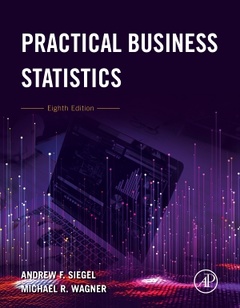Practical Business Statistics (8th Ed.)
Auteurs : Siegel Andrew F., Wagner Michael R.

Practical Business Statistics, Eighth Edition, offers readers a practical, accessible approach to managerial statistics that carefully maintains, but does not overemphasize mathematical correctness. The book fosters deep understanding of both how to learn from data and how to deal with uncertainty, while promoting the use of practical computer applications. This trusted resource teaches present and future managers how to use and understand statistics without an overdose of technical detail, enabling them to better understand the concepts at hand and to interpret results.
The text uses excellent examples with real world data relating to business sector functional areas such as finance, accounting, and marketing. Written in an engaging style, this timely revision is class-tested and designed to help students gain a solid understanding of fundamental statistical principles without bogging them down with excess mathematical details.
Part I: Introduction and Descriptive Statistics 1. Introduction: Defining the Role of Statistics in Business 2. Data Structures: Classifying the Various Types of Data Sets 3. Histograms: Looking at the Distribution of Data 4. Landmark Summaries: Interpreting Typical Values and Percentiles 5. Variability: Dealing with Diversity
Part II: Probability 6. Probability: Understanding Random Situations 7. Random Variables: Working with Uncertain Numbers
Part III: Statistical Inference 8. Random Sampling: Planning Ahead for Data Gathering 9. Confidence Intervals: Admitting That Estimates Are Not Exact 10. Hypothesis Testing: Deciding Between Reality and Coincidence
Part IV: Regression and Time Series 11. Correlation and Regression: Measuring and Predicting Relationships 12. Multiple Regression: Predicting One Variable From Several Others 13. Report Writing: Communicating the Results of a Multiple Regression 14. Time Series: Understanding Changes Over Time
Part V: Methods and Applications 15. ANOVA: Testing for Differences Among Many Samples and Much More 16. Recent Developments 17. Chi-Squared Analysis: Testing for Patterns in Qualitative Data 18. Quality Control: Recognizing and Managing Variation
19. Statistical (Machine) Learning: Using Complex Models With Large Data Sets
Michael R. Wagner is an Associate Professor of Operations Management and a Neal and Jan Dempsey Endowed Faculty Fellow at the Michael G. Foster School of Business, University of Washington, Seattle. His Ph.D. is in Operations Research from MIT (2006). He has taught data analytics at both undergraduate and graduate levels, and earned the Ron Crockett Award for Innovation in Education (2014). His articles have appeared in many publications, including the journals Management Science, Operat
- Provides users with a conceptual, realistic, and matter-of-fact approach to managerial statistics
- Offers an accessible approach to teach present and future managers how to use and understand statistics without an overdose of technical detail, enabling them to better understand concepts and to interpret results
- Features updated examples and images to illustrate important applied uses and current business trends
- Includes robust ancillary instructional materials such as an instructor’s manual, lecture slides, and data files
Date de parution : 04-2022
Ouvrage de 560 p.
21.5x27.6 cm
Thème de Practical Business Statistics :
Mots-clés :
Stats; Economics; Finance; Data Sets; Histogram; Data Distribution; Typical Values; Percentiles; Variability; Probability; Randomness; Uncertain Numbers; Sampling; Data collection; Confidence Intervals; Hypothesis Testing; Correlation; Regression; Multiple Regression; Time Series; ANOVA; Ordinal Data; Nonnormal Distributions; Chi-Squared Analysis; Qualitative Data; Quality Control



